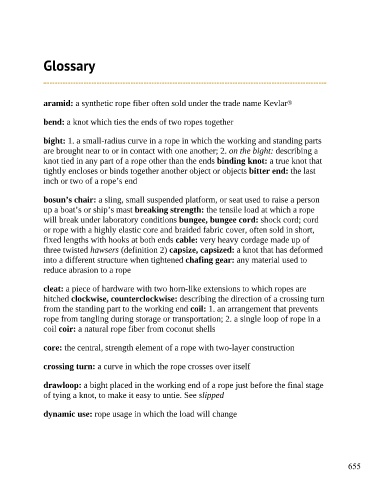Page 659 - Bob Holtzman "The Field Guide to Knots How to Identify, Tie, and Untie Over 80 Essential Knots for Outdoor Pursuits"
P. 659
Glossary
aramid: a synthetic rope fiber often sold under the trade name Kevlar ®
bend: a knot which ties the ends of two ropes together
bight: 1. a small-radius curve in a rope in which the working and standing parts
are brought near to or in contact with one another; 2. on the bight: describing a
knot tied in any part of a rope other than the ends binding knot: a true knot that
tightly encloses or binds together another object or objects bitter end: the last
inch or two of a rope’s end
bosun’s chair: a sling, small suspended platform, or seat used to raise a person
up a boat’s or ship’s mast breaking strength: the tensile load at which a rope
will break under laboratory conditions bungee, bungee cord: shock cord; cord
or rope with a highly elastic core and braided fabric cover, often sold in short,
fixed lengths with hooks at both ends cable: very heavy cordage made up of
three twisted hawsers (definition 2) capsize, capsized: a knot that has deformed
into a different structure when tightened chafing gear: any material used to
reduce abrasion to a rope
cleat: a piece of hardware with two horn-like extensions to which ropes are
hitched clockwise, counterclockwise: describing the direction of a crossing turn
from the standing part to the working end coil: 1. an arrangement that prevents
rope from tangling during storage or transportation; 2. a single loop of rope in a
coil coir: a natural rope fiber from coconut shells
core: the central, strength element of a rope with two-layer construction
crossing turn: a curve in which the rope crosses over itself
drawloop: a bight placed in the working end of a rope just before the final stage
of tying a knot, to make it easy to untie. See slipped
dynamic use: rope usage in which the load will change
655

